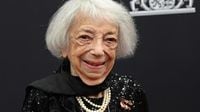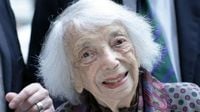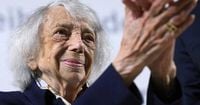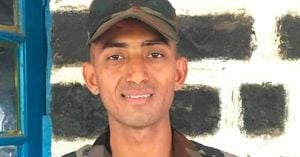Margot Friedländer, a German Jew who survived the Theresienstadt concentration camp and became a high-profile witness to Nazi persecution, has died at the age of 103. Her death was announced by the Margot Friedländer Foundation in Berlin on Friday evening, May 9, 2025. Notably, she passed away during the week of the 80th anniversary of Nazi Germany's unconditional surrender in World War II.
Friedländer spent much of her life in the United States before returning to Berlin in her 80s. She was honored with Germany's highest decoration and had a statue erected in her honor at Berlin's City Hall. "What I do gives me my strength and probably also my energy, because I speak for those who can no longer speak," Friedländer said at an event at Berlin's Jewish Museum in 2018. "I would like to say that I don't just speak for the six million Jews who were killed, but for all the people who were killed — innocent people," she added.
German President Frank-Walter Steinmeier expressed his condolences, stating that Friedländer gave Germany reconciliation despite the horrors she endured. A report released last month indicated that more than 200,000 Jewish survivors are still alive, but 70% of them will be gone within the next decade.
Born Margot Bendheim on November 5, 1921, her father, Artur Bendheim, owned a shop in Berlin and had fought for Germany during World War I, earning decorations for his service. After her parents divorced in 1937, Friedländer, her mother, and her younger brother moved in with her grandparents. By 1941, they were forced to relocate to a so-called "Jewish apartment," and Friedländer was compelled to work nights at a metal factory.
In January 1943, just as her family was planning to flee Berlin, Friedländer returned home to find that her brother, Ralph, had been taken away by the Gestapo. A neighbor informed her that her mother had decided to go to the police to join Ralph. She passed on her mother’s final message — "Try to make your life," which would later become the title of Friedländer's autobiography — along with her handbag.
Friedländer went into hiding, removing the yellow star that Jews were required to wear. She dyed her hair red, reasoning that "people think Jews don’t have red hair." During the next 15 months, 16 people helped keep her safe from the Nazis. However, in April 1944, her hiding came to an end when she was arrested following an identity check after leaving a bunker during an air raid. She decided to tell the truth about her Jewish identity. "The running and hiding was over," she recalled. "I felt separated from the fate of my people. I had felt guilty every day; had I gone with my mother and my brother, I would at least have known what had happened to them."
Friedländer arrived at the packed Theresienstadt camp in June 1944. In the spring of 1945, she witnessed the arrival of skeletal prisoners who had been forced onto death marches from Auschwitz ahead of the camp’s liberation. "At that moment, we heard of the death camps, and at that moment I understood that I would not see my mother and my brother again," she recounted. Both were ultimately killed at the Auschwitz death camp. Her father had fled to Belgium in 1939, then was interned in France before being deported to Auschwitz in 1942, where he also perished.
Shortly after the camp’s liberation, she married Adolf Friedländer, an acquaintance from Berlin whom she had met again at Theresienstadt. They emigrated to New York in 1946 after spending months in a camp for displaced persons. Friedländer stayed away from Germany for 57 years. She and her husband became U.S. citizens, with Friedländer working as a tailor and later running a travel agency. Adolf Friedländer died in 1997 at the age of 87.
Margot returned to Germany for the first time in 2003, receiving a warm welcome at Berlin’s City Hall alongside others who had been forced out by the Nazis. In 2010, she moved back to Berlin permanently, where she shared her story with students and was awarded numerous honors, including the country’s highest honor, the Order of Merit. She was made a citizen of honor of Berlin in 2018.
Friedländer often emphasized the importance of memory as a form of resistance. “I would like you to be the witnesses we can’t be for much longer,” she told an audience in 2018. She became a prominent voice against antisemitism and a champion of reconciliation, warning against the resurgence of hate. "This is how it began," she would say, urging vigilance against the creeping tide of prejudice.
Her passing marks the loss of one of the last living links to the Holocaust, but it also serves as a call to action for the living. As one observer noted, "Margot’s death is not just the loss of a person. It’s the extinguishing of one of our era’s brightest moral compasses." As we mourn her loss, we must also remember her legacy and the stories she carried.
In a world increasingly challenged by division and intolerance, Friedländer's life and words remind us of the importance of empathy and humanity. "Be human! That is what I ask you to do: be human!" she urged, a mantra that resonates deeply in today's society. Margot Friedländer not only survived; she thrived, transforming her pain into a powerful message of hope and remembrance.






